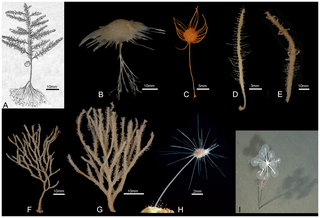
The blue whale is a marine mammal and a baleen whale. Reaching a maximum confirmed length of 29.9 meters (98 ft) and weighing up to 199 tonnes, it is the largest animal known ever to have existed. The blue whale's long and slender body can be of various shades of greyish-blue dorsally and somewhat lighter underneath. Four subspecies are recognized: B. m. musculus in the North Atlantic and North Pacific, B. m. intermedia in the Southern Ocean, B. m. brevicauda in the Indian Ocean and South Pacific Ocean, and B. m. indica in the Northern Indian Ocean. There is also a population in the waters off Chile that may constitute a fifth subspecies.

Cladorhiza is a genus of carnivorous sponges, comprising around 40 species found in oceans around the world. Cladorhiza is the type genus of the family Cladorhizidae.

Gymnothorax is a genus of fish in the family Muraenidae found in Atlantic, Indian and Pacific Ocean. With more than 120 species, it the most speciose genus of moray eels.

Chondrocladia is a genus of carnivorous demosponges of the family Cladorhizidae. Neocladia was long considered a junior synonym, but has recently become accepted as a distinct genus.

A giant isopod is any of the almost 20 species of large isopods in the genus Bathynomus. They are abundant in the cold, deep waters of the Atlantic, Pacific, and Indian Oceans. Bathynomus giganteus, the species upon which the generitype is based, is often considered the largest isopod in the world, though other comparably poorly known species of Bathynomus may reach a similar size. The giant isopods are noted for their resemblance to the much smaller common woodlouse, to which they are related.

Parapercis is a genus of sandperches belonging to the fish family Pinguipedidae.

Chondrocladia lyra, also known as the lyre sponge or harp sponge, is a species of carnivorous deep-sea sponge first discovered off the Californian coast living at depths of 10,800–11,500 feet (3,300–3,500 m) by Welton L. Lee, Henry M Reiswig, William C. Austin, and Lonny Lundsten from the Monterey Bay Aquarium Research Institute (MBARI).

Cladorhizidae is a family of carnivorous demosponges found in deep-sea environments worldwide. These sponges are known for their unique feeding structures and predatory behavior, as they capture and consume small animals such as crustaceans.
Cladorhiza caillieti is a carnivorous sponge of the family Cladorhizidae described in 2014 from specimens collected from the Juan de Fuca Ridge off the coast of Vancouver Island. It feeds on small crustaceans such as amphipods and copepods. C. caillieti is an elongate, bottlebrush-shaped sponge with filaments projecting from a main stem, and ranges from 7 to 9 cm in height. The specific epithet honors Dr. Gregor M. Cailliet of the Moss Landing Marine Laboratories.
Gregor Michel Cailliet is an American scientist who studies the ecology of marine fishes. He is professor emeritus at Moss Landing Marine Laboratories, part of The California State University, having officially retired in 2009.
Cladorhiza evae is a species of carnivorous sponge native to hydrothermal vents in the Gulf of California.
Axoniderma is a genus of carnivorous demosponges in the family Cladorhizidae.
Jean Vacelet is a French marine biologist who specialises in the underwater fauna of the Mediterranean. After earning his licence at the Faculté des Sciences de Marseille and learning to dive in 1954, he specialised in the study of sponges at the Marine station of Endoume, and there he has stayed faithful to both sponges and place for more than half a century. His research has included all aspects of sponges: taxonomy, habitat, biology, anatomy, their bacterial associations, and their place in the evolution of multi-celled animals. He has studied them not only in the Mediterranean but in the Indian Ocean and the Pacific. Exploration of underwater grottoes, together with Jacques Laborel and Jo Hamelin, revealed the existence of sponges dating from very ancient geological periods and the unexpected existence of carnivorous sponges, and surprisingly, the grottoes in some ways mimicked life at much greater depths.
Neopolynoe antarctica is a scale worm known from the Magallanes Region of the South Atlantic Ocean and from the Southern Ocean south of New Zealand at depths to about 200 m.
Michelle Kelly, also known as Michelle Kelly-Borges, is a New Zealand scientist who specialises in sponges, their chemistry, their evolution, taxonomy, systematics, and ecology.
Axoniderma australis is a species of demosponge in the family Cladorhizidae. It is known from type specimens found off the coasts of Tasmania and New South Wales.
Axoniderma poritea is a species of demosponge in the family Cladorhizidae. It is known from type specimens found on the east coast of Australia.
Axoniderma hubbsi is a species of demosponge in the family Cladorhizidae. It is known from type specimens found in the northeast Pacific Ocean.
Axoniderma mexicana is a species of demosponge in the family Cladorhizidae. It is known from type specimens found around Mexico.







